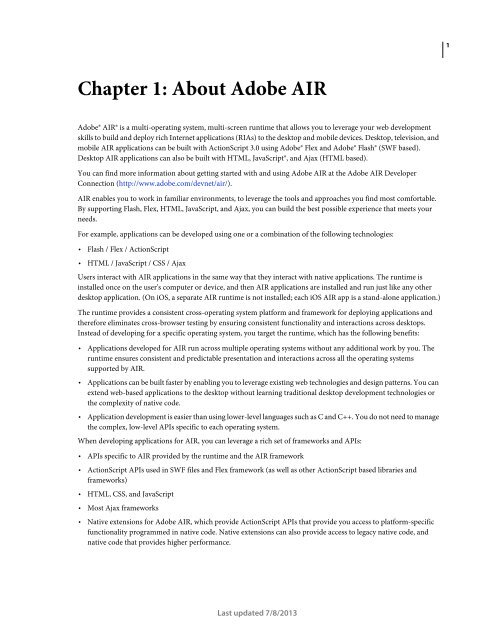Building Adobe AIR Applications
Building Adobe AIR Applications
Building Adobe AIR Applications
You also want an ePaper? Increase the reach of your titles
YUMPU automatically turns print PDFs into web optimized ePapers that Google loves.
Chapter 1: About <strong>Adobe</strong> <strong>AIR</strong><br />
<strong>Adobe</strong>® <strong>AIR</strong>® is a multi-operating system, multi-screen runtime that allows you to leverage your web development<br />
skills to build and deploy rich Internet applications (RIAs) to the desktop and mobile devices. Desktop, television, and<br />
mobile <strong>AIR</strong> applications can be built with ActionScript 3.0 using <strong>Adobe</strong>® Flex and <strong>Adobe</strong>® Flash® (SWF based).<br />
Desktop <strong>AIR</strong> applications can also be built with HTML, JavaScript®, and Ajax (HTML based).<br />
You can find more information about getting started with and using <strong>Adobe</strong> <strong>AIR</strong> at the <strong>Adobe</strong> <strong>AIR</strong> Developer<br />
Connection (http://www.adobe.com/devnet/air/).<br />
<strong>AIR</strong> enables you to work in familiar environments, to leverage the tools and approaches you find most comfortable.<br />
By supporting Flash, Flex, HTML, JavaScript, and Ajax, you can build the best possible experience that meets your<br />
needs.<br />
For example, applications can be developed using one or a combination of the following technologies:<br />
Flash / Flex / ActionScript<br />
HTML / JavaScript / CSS / Ajax<br />
Users interact with <strong>AIR</strong> applications in the same way that they interact with native applications. The runtime is<br />
installed once on the user's computer or device, and then <strong>AIR</strong> applications are installed and run just like any other<br />
desktop application. (On iOS, a separate <strong>AIR</strong> runtime is not installed; each iOS <strong>AIR</strong> app is a stand-alone application.)<br />
The runtime provides a consistent cross-operating system platform and framework for deploying applications and<br />
therefore eliminates cross-browser testing by ensuring consistent functionality and interactions across desktops.<br />
Instead of developing for a specific operating system, you target the runtime, which has the following benefits:<br />
<strong>Applications</strong> developed for <strong>AIR</strong> run across multiple operating systems without any additional work by you. The<br />
runtime ensures consistent and predictable presentation and interactions across all the operating systems<br />
supported by <strong>AIR</strong>.<br />
<strong>Applications</strong> can be built faster by enabling you to leverage existing web technologies and design patterns. You can<br />
extend web-based applications to the desktop without learning traditional desktop development technologies or<br />
the complexity of native code.<br />
Application development is easier than using lower-level languages such as C and C++. You do not need to manage<br />
the complex, low-level APIs specific to each operating system.<br />
When developing applications for <strong>AIR</strong>, you can leverage a rich set of frameworks and APIs:<br />
APIs specific to <strong>AIR</strong> provided by the runtime and the <strong>AIR</strong> framework<br />
ActionScript APIs used in SWF files and Flex framework (as well as other ActionScript based libraries and<br />
frameworks)<br />
HTML, CSS, and JavaScript<br />
Most Ajax frameworks<br />
Native extensions for <strong>Adobe</strong> <strong>AIR</strong>, which provide ActionScript APIs that provide you access to platform-specific<br />
functionality programmed in native code. Native extensions can also provide access to legacy native code, and<br />
native code that provides higher performance.<br />
Last updated 7/8/2013<br />
1

















